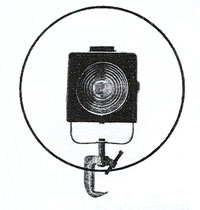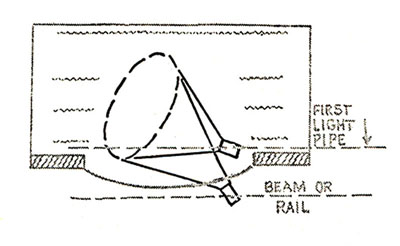

BY TOM SKELTON
courtesy of
Dance Magazine
first published
September 1956
TOOLS OF LIGHTING DESIGN: LIGHTING MISCELLANY
Masking
Bad masking is a serious problem that often mars the professionalism of a performance. When the spotlights are being focused, great care must be taken to be sure that no light is spilled onto the proscenium or into the orchestra pit (or on the necks of the audience. Spotlights of the ellipsoidal reflector type have built-in masking shutters. This makes masking easy if all of the nuts and bolts on the spotlight are tightened so that it doesn’t drop out of focus after it is set.
Front lighting must be focused low enough so that the dancers do not cast shadows on the backdrop. When spotlights are mounted on the balcony rail or some other equally low position, however, these shadows are inevitable since the dancer is in a straight line between the spotlights and the backdrop.
If the backdrop is scenery rather than a sky-drop or “neutral” drapery, it is usually possible to mask the light beams to a line in the scenery, such as the top of a door or window, or the trunk of a tree. In this way the shadows still exist but the line of demarcation on the scenery is less obvious.
If the background is a sky-drop, however, any shadow on it will destroy the illusion of depth. Shadows can sometimes be “washed out” if the color of the front lighting is similar to the desired sky color (such as steel blue front lighting of a light blue sky) providing enough actual illumination from many sources can be poured onto the sky-drop. But enough equipment to do this is rarely available. The only solution is to cross-focus the front lighting so that the shadows are on the sides of the stage rather than on the sky-drop. In other words, the spotlight on the extreme right over the audience’s heads should be focused to cover the left half (or stage right) of the stage.
When black draperies are used there is rarely a problem at all, since the draperies will absorb almost all of the light that is put on it and the shadows will not show. The s0-called “neutral draperies” of beige or gray present the same problems as a sky-drop, and all spotlights should be focused so that there is no light on them at all.
Side lighting does not cause as much trouble as front lighting. When the spotlights are focused be sure they do not spill on the nearest wing, making it disproportionately bright. Naturally they shouldn’t be allowed to spill on the backdrop either. Even more distracting is a spill into the auditorium where it may hit the walls or actually shine into someone’s eyes. This can usually be prevented by moving the boom or standard further offstage.
The chief problem with side lighting is that the boom or standard on which the spotlight is mounted can be easily knocked out of focus by a passing dancer or by a dancer who uses it as a barre for warm-ups. So the boom must be securely fastened to the floor, or a chalk mark drawn across the base of the boom on the floor so that one glance can tell you if the boom is still in position.
Overhead lighting from the spotlights mounted on the first light pipe can be troublesome because it is difficult to get enough light into the upstage areas of the stage without spilling onto the backdrop. Side lighting from the upstage wings will provide sufficient illumination to eliminate the problem, but if side lighting is not available the best solution again is to cross-focus so that the spotlight mounted on the extreme right end of the first light pipe is focused to cover the left half of the stage and the shadows go off into the wings rather than onto the backdrop.

Many times after a spotlight has been focused, you will discover a little spill on a border or a leg which draws attention away from the dance area. Well-equipped theatres often have tin cones called “stove pipes” or “top hats” that fit over the front of the spotlight and mask any spill. Sometimes these cones mask off too much light, however, and it is necessary to improvise a masking from a sheet of asbestos or kitchen aluminum foil for only one side of the spotlight. The aluminum foil can be pressed around the spotlight in the shape of a cone and the surplus cut away with scissors. The asbestos can be held in position with tape or wire. This method works for fresnels or projector lamps or other types of equipment which have a light beam with a soft edge. Sharp-edged spotlights like the Leko, Kleiglite, plano-convex, or floodlight can be masked by cutting an appropriately-shaped piece of foil or asbestos and putting it in the gel frame with the gelatine. It works like a window blind and will make a sharp line.
Curtain Lights
Have you ever been to a performance where the house-lights go out while you are looking for your seat and you’re left standing there in pitch darkness until the curtain opens? If so, I think you will remember how irritating it can be not only to you but to all the people you disturb as you climb to your seat after the performance has begun. This happens most often in auditoriums where the house-lights are not on dimmers, and denotes lack of advance planning or thoughtlessness on the part of the stage manager. If the house-lights are not on dimmers, they are generally on several different switches, and it would be possible to turn to them off one at a time. This would warn the audience and gives everyone time to scramble to his seat.
Let me ask you another question: do you remember how exciting it is when the house-lights go out and the curtain lights come up? Those few seconds before the curtain opens are treasured by everyone who loves theatre. It’s a sure-fire trick to build the audience’s anticipation, and it’s easy to do.
If the house-lights are not on dimmers, switch half of them off and then turn on the footlights. Wait a few seconds and then switch off the rest of the house-lights. Wait a few more seconds until the audience is quiet and then start the overture or open the curtain, whichever comes first. If the foots are on dimmers, they should be dimmed out just before the curtain opens. If they are not on dimmers they can be switched out at the same second the curtain starts to open. If the house-lights are on dimmers, it’s even easier: as they slowly dim out, the foots come up.
It’s a worthwhile effect, and will add to the professionalism of the performance. Like all effects, it should be rehearsed and polished and timed just right.
(continued next month)